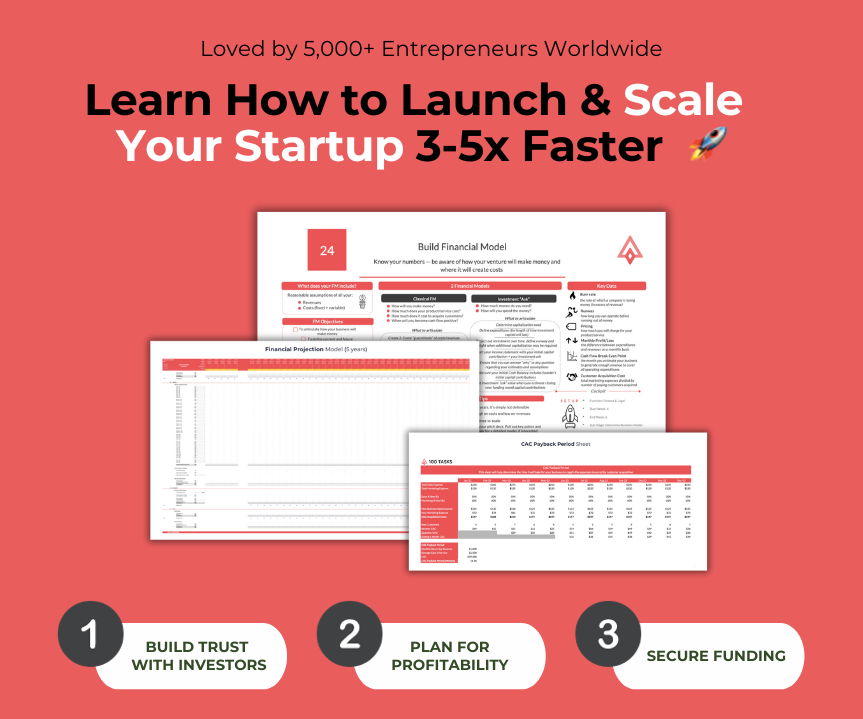These 10 pivotal questions will help guide your business planning process so you can start writing a business plan for your new startup.
In a previous article, we created a business plan outline to help entrepreneurs and new business owners in their business plan preparation process.
In this article, we embark on a journey into the heart of strategic brilliance as we unveil the pivotal questions that will sculpt your business’s operational and marketing strategy, igniting the path to crafting the ultimate business plan for your new venture.
Each question is a key, ready to unlock new insights and unveil the thrilling possibilities that await. So, fasten your seatbelt, ignite your entrepreneurial spirit, and embark on the exhilarating adventure of crafting your business plan for your brand-new startup!
Contents
- 10 Pivotal Questions to Start Writing a Business Plan
- #1. Who is your target audience?
- #2. What is your product pricing strategy?
- #3. Who is your competition?
- #4. What is your business marketing plan?
- #5. What is your go-to-market strategy?
- #6. What are your financial projections?
- #7. How will you implement your business strategy?
- #8. Where will you find business financing?
- #9. Do you need shipping?
- #10. How will you accept payments?
- Business & Leadership Tips
10 Pivotal Questions to Start Writing a Business Plan
Unlock the secrets to entrepreneurial success with these 10 pivotal questions. They are the North Star guiding your journey through the exhilarating realm of business planning, paving the way for the creation of an electrifying blueprint for your startup’s future.
#1. Who is your target audience?
Unlock the potential of your online venture by honing in on your target market, those eager visitors who will flock to your digital doorstep. In the vast realm of cyberspace, the key to profitability lies in generating a substantial stream of traffic.
Picture a diverse audience: mothers seeking convenience, sharp-witted business executives on the lookout for innovation, tech-savvy teens exploring the next big thing, wise older adults with a thirst for knowledge, and even the curious minds of children.
Your startup’s blueprint for success should be a comprehensive masterpiece, meticulously crafted to embrace all these potential audiences. So, when you plan your strategy, remember to cast your net wide and watch as your online empire takes shape.
#2. What is your product pricing strategy?
Have you set the perfect price tag for your product or service? Determining the ideal pricing strategy is a delicate art, one that requires a thorough analysis of your competition. Striking the right balance is the key – not too high to deter potential customers, yet not too low to jeopardize your profitability.
In your meticulously crafted pricing strategy business plan, it’s paramount to ensure that your offering falls within the sweet spot, where your customers can comfortably afford your product or service while still allowing you to reap a respectable profit.
Put yourself in the shoes of your customers, embark on a journey to explore the pricing landscapes of similar products and services, and embark on a quest to craft the perfect narrative for your offering in the business plan.
By doing so, you’ll ensure your pricing strategy aligns seamlessly with the desires of your target audience, setting the stage for a successful venture.
#3. Who is your competition?
In the fast-paced world of business, it’s a perilous mistake to shield your eyes from your competition. They’re like speed demons on the highway, and unless you open your eyes wide, you risk being left in their dust, struggling to catch up.
Competing effectively is the lifeblood of success in the online business arena. It’s imperative to not only acknowledge your competitors but also to understand what sets you apart. Your product or service should shimmer with uniqueness amidst a sea of similarities.
If your products or services dance in the same arena as others, dive headfirst into their territory. Examine their strengths and, even more critically, pinpoint their weaknesses. It’s these chinks in their armor that will fuel your journey toward improvement, enabling your product or service to rise above the rest.
Mastery of crafting the perfect competition analysis in your business plan is your secret weapon. It’s a tool that will help you gauge the costs involved in creating and marketing your offering while formulating a marketing strategy that’s utterly distinctive to your online presence.
So, don’t just keep your eyes open; keep them wide open by writing a comprehensive competitive analysis in your business plan, and let your competitors be the catalysts for your rise to the top.
#4. What is your business marketing plan?
Now, it’s time to dive into the heart of your business’s success: creating a robust marketing plan. While it may be more challenging than crafting your mission statement, it’s an absolute necessity. This plan will be the cornerstone of your efforts to showcase your unique products and services to the world.
If you find yourself lacking in marketing expertise, don’t worry. There’s a wealth of digital marketing service providers available online to guide you through the planning process. They can equip you with the latest tools and strategies to effectively promote your offerings in the digital realm.
Your marketing plan should be a dynamic blueprint that incorporates a multitude of online advertising methods. Explore the vast potential of search engine traffic, harness the power of paid advertising, make your mark with eye-catching banner ads, cultivate an engaging blog, and craft compelling articles.
Dedicating ample time and attention to your sales and marketing plan within your business proposal is non-negotiable. It’s the linchpin of your business growth strategy, the roadmap to reaching new heights in your entrepreneurial journey.
#5. What is your go-to-market strategy?
In the bustling landscape of today’s markets, the art of positioning your product or service is your golden ticket to standing tall amidst the crowd. It’s a skill that separates the successful from the bewildering multitude of businesses that inadvertently confuse their customers with inconsistent messages.
Your path to triumph lies in crystallizing your unique value proposition, zeroing in on your target market, and honing your product positioning. This trifecta serves as the guiding star to your success. At its core, your go-to-market strategy is the bedrock upon which your entire business strategy is built, directing five pivotal actions:
- Defining Your Target Customer: The first step is to precisely identify who your ideal customer is and how to connect with them effectively.
- Communicating Value: You must master the art of articulating the value your products and services offer, ensuring your message resonates with your customers.
- Pricing Strategy: Striking the right pricing balance is crucial. It involves more than just numbers; it’s about perception and value.
- Competitive Differentiation: In a sea of options, what sets you apart? Your unique selling points are the lighthouse that guides customers to your shores.
- Sales and Marketing Tactics: Finally, your go-to-market strategy dictates the most effective methods for selling and marketing your offerings to your target audience. It’s the playbook for your business’s success.
In a world teeming with choices, your ability to navigate these five key actions with finesse will not only set you apart but propel you toward the pinnacle of your industry.
#6. What are your financial projections?
In the grand scheme of your business’s growth, strategic financial planning is the bedrock upon which your success is built. It’s a fundamental element that should never be omitted, especially when you’re gearing up to present an investor pitch deck.
Investors are discerning, and they’ll invariably inquire about your financial projections for your startup. As an entrepreneur, having a financial plan for your startup business at your fingertips is not just recommended; it’s expected.
If navigating the financial landscape seems daunting, consider enlisting the expertise of tax planners or a seasoned financial advisor. They can be your guiding light, helping you craft a meticulous financial plan and projections.
They’ll provide you with the financial wisdom you need to establish clear financial management goals and compose a compelling financial plan within the realm of entrepreneurship. With their assistance, you’ll learn how to master the art of creating a flawless financial write-up within your business plan.
This includes simplifying the process of creating, interpreting, and forecasting all essential financial statements and performing a comprehensive ratio analysis. With these tools in your arsenal, you’ll not only meet investor expectations but also steer your business toward financial prosperity.
#7. How will you implement your business strategy?
When it comes to implementing the steps required to execute your business strategy, you’ll often find a mix of in-house tasks and outsourced expertise to be the most efficient approach. The specific tasks you outsource and the partners you collaborate with will depend on your business’s needs and your available resources.
Here’s a breakdown of the key considerations for the organizational structure in business plans:
- Task Assessment: Begin by evaluating each task or function in your business plan. Determine which ones require specialized skills or resources that are not readily available in-house.
- Outsourcing: Tasks that fall outside your core competencies or are highly specialized, such as legal, accounting, or web development services, are prime candidates for outsourcing. Look for reputable professionals or firms with expertise in these areas.
- Cost Analysis: Compare the cost of outsourcing these tasks to the expense of hiring and training in-house staff, including salaries, benefits, and ongoing development costs. Make sure to consider the quality and expertise you’ll receive from outsourcing.
- Efficiency and Expertise: Outsourcing can often lead to greater efficiency and access to expert knowledge, allowing you to focus on your core business activities.
- Cash Flow Management: By carefully budgeting for outsourcing expenses and considering how they fit into your overall financial plan, you can ensure that you don’t run out of cash. This might involve negotiating payment terms or exploring financing options.
- Operational Plan: Develop an annual operational plan within your business strategy that outlines the specific tasks, timelines, and budgets for each element of your business plan, including both in-house and outsourced activities.
- Management Team: In your business plan, detail the composition of your management team, including any external advisors or partners. Highlight their expertise and roles in executing the business strategy.
- Milestone Tracking: Create a milestone write-up in your business plan to track your progress. Set clear, measurable milestones and timelines for achieving key objectives. Regularly review and adjust these milestones as needed.
A business plan course can be an invaluable resource in helping you make informed decisions about outsourcing, budgeting, and creating an effective action plan.
With a well-thought-out approach and the right mix of in-house and outsourced expertise, you can efficiently implement your business strategy without jeopardizing your financial stability.
#8. Where will you find business financing?
Do you know the #1 reason businesses fail? They run out of cash. Cash flow management is indeed one of the most common reasons why businesses fail. It’s vital to have a clear understanding of where your business capital will come from and how you’ll manage it effectively.
Do you know where your business capital is going to come from? Are you going to finance it from your savings, take a loan, or invite partners, venture capitalists, or angel investors to help you finance it?
How are you going to manage your cash flow and who will help you maintain accounts? Here are some considerations:
- Capital Sources: Determine the sources of your initial capital. Will it come from your savings, a business loan, or investment from partners, venture capitalists, or angel investors? Each source has its implications in terms of control, repayment, and equity sharing.
- Cash Flow Management: Develop a robust cash flow management strategy. This should include detailed financial projections, a budget, and a plan for monitoring income and expenses. Understanding the timing of cash inflows and outflows is critical.
- Accounting and Bookkeeping: Decide who will handle your accounting and bookkeeping. This could be an in-house accountant or an outsourced accounting firm. Keeping accurate financial records is essential for making informed decisions.
- Investor Relations: If you plan to seek outside funding, create a compelling startup presentation or pitch deck. This should highlight your business concept, market opportunity, financial projections, and the potential return on investment for investors.
- Risk Assessment: Identify potential financial risks and develop contingency plans. What will you do if your cash flow falls short of projections? Having a plan in place can prevent financial crises.
- Working Capital: Maintain a cushion of working capital to cover unexpected expenses and ensure you can operate smoothly during lean periods.
- Reinvestment and Growth: Consider how you’ll reinvest profits for growth. Will you expand your product line, enter new markets, or scale operations? These decisions impact your cash flow.
- Financial Expertise: If you lack financial expertise, it’s advisable to seek the help of a financial advisor or consultant who can guide you in creating accurate financial projections and managing your finances effectively.
Ultimately, your business plan should encompass all of these aspects, providing a comprehensive roadmap for how you will secure, manage, and allocate your capital. With a well-thought-out financial strategy, you can approach potential investors with confidence and navigate the complexities of business finance successfully.
#9. Do you need shipping?
If your product is physically delivered, you will have to decide on a shipping method and price that is acceptable to your customer. If your business is online, you should plan for the possibility of getting customers from different parts of the world.
When dealing with physically-delivered products, the logistics of shipping are crucial aspects of your business. Here are some considerations to keep in mind:
- Shipping Method: Choose a shipping method that aligns with the preferences and needs of your customers. Consider factors like speed, reliability, and cost. Offering multiple shipping options can be a customer-friendly approach.
- Shipping Pricing: Determine a fair and competitive shipping price. Be transparent about shipping costs on your website so customers know what to expect. Consider offering free shipping for orders over a certain amount to incentivize larger purchases.
- International Shipping: If your business operates online and attracts customers from different parts of the world, plan for international shipping. Research the regulations and customs requirements for shipping to different countries and communicate any potential delays or additional costs to international customers.
- Shipping Details: Clearly post shipping details, including estimated delivery times and tracking information, on your website. This helps build trust with customers and reduces inquiries about order status.
- Shipping Insurance: For valuable products, offering shipping insurance is a smart move, especially for international shipments. It provides peace of mind to both you and your customers in case of loss, damage, or theft during transit.
- Returns and Refunds: Develop a clear policy for returns and refunds in case customers are dissatisfied with the product or if there are shipping issues. Make this policy easily accessible on your website.
- Packaging: Invest in appropriate packaging materials to protect your products during transit. Quality packaging can reduce the likelihood of damage and customer complaints.
- Shipping Partners: Choose reliable shipping partners or carriers that have a good track record for on-time deliveries and safe handling of packages.
By addressing these shipping considerations in your business plan and implementing them in your operations, you can enhance the customer experience, reduce shipping-related issues, and build a reputation for reliability and transparency in your business.
#10. How will you accept payments?
Accepting payments is a critical aspect of any online business. Most online businesses accept credit cards and if you choose this option, you will need to decide between merchant accounts or third-party processing centers.
Some online businesses accept money orders or checks. Will your business accept them too? Here are some considerations for choosing how to accept payments:
- Credit Card Processing: Most online businesses do indeed accept credit card payments as they are convenient and widely used. To do this, you can either set up a merchant account or use a third-party payment processing service like PayPal, Stripe, or Wise.
- Merchant Account: This option allows you to have more control over the payment process and potentially lower transaction fees, especially if you have a high volume of sales. However, it often involves a more complex setup process and may require a credit check.
- Third-Party Processor: Using a third-party processor can be simpler and faster to set up. These services often have user-friendly integrations and may not require a credit check. However, they may charge slightly higher transaction fees.
- Alternative Payment Methods: Besides credit cards, consider whether you want to accept alternative payment methods such as digital wallets (e.g., Apple Pay, Google Wallet), money orders, checks, or even cryptocurrency. Offering multiple payment options can attract a broader range of customers.
- Security and Fraud Prevention: Whichever payment method you choose, prioritize security and implement measures to prevent fraud and protect customer data. This includes using secure payment gateways, and SSL certificates, and complying with relevant data protection regulations (e.g., GDPR).
- International Payments: If your business serves an international customer base, ensure that your payment processing methods can accommodate different currencies and payment preferences. Consider the implications of currency conversion and any associated fees.
- Payment Processing Fees: Understand the fee structures associated with your chosen payment methods. Transaction fees, monthly fees, chargeback fees, and currency conversion fees can impact your profitability.
- Customer Experience: Prioritize a smooth and user-friendly payment process to minimize cart abandonment rates. Test your payment flow regularly to identify and resolve any issues.
Ultimately, your choice of payment methods should align with your target audience’s preferences, your business model, and your ability to manage the associated administrative and security requirements. It’s often a good idea to offer multiple payment options to accommodate different customer preferences.
With the wisdom of a well-crafted business plan and the guidance of experienced business mentors your entrepreneurial journey can begin with boundless possibilities. But here’s a pro tip: don’t go at it alone! Seek out the services of a seasoned business plan service provider.
They’re the guardians of your dreams, the protectors against costly missteps that can plague any online business endeavor. Think of them as the wise wizards of the entrepreneurial world, ensuring your path is well-lit and peril-free.
While the tips above will help you learn the importance of planning in business, these business courses will help you gain the entrepreneurial skills you need to launch and grow a successful business.
Business & Leadership Tips
- The Ultimate Founders Checklist to Launch & Scale Your Startup
- 10 Steps To Write a Startup Business Plan In Entrepreneurship
- Best ChatGPT Prompts for Writing a Business Plan
- How To Write The Perfect Elevator Pitch For Investors
- How to Create a Compelling Company Vision as an Entrepreneur
- 25 Entrepreneur Characteristics Of Successful Business Owners
- How To Go From Employee To Entrepreneur Mindset
- Best Business Courses To Learn Entrepreneur Skills
- 52 Critical Business Skills For Success
- How to Find a Business Partner for Entrepreneurial Success
- How To Learn Powerful Negotiation Skills In The Workplace
- How To Use The Law Of Attraction For Business Success
- How to Write Clearly and Concisely with Business Writing Courses
- E-Business Tools, Banking Tools & Small Business Finance Tools
- Best Recession-Proof Businesses To Start In An Economic Downturn
© 2023 – 2024, Priya Florence Shah. All rights reserved.
Priya Florence Shah is a bestselling author and an award-winning blogger. Check out Devi2Diva, her book on emotional self-care for women. In her spare time, Priya writes science-fiction novels and poetry and chills with her two-legged and four-legged kids.
Discover more from Business & Branding Tips
Subscribe to get the latest posts sent to your email.















